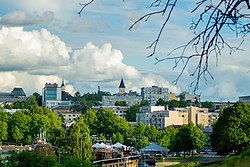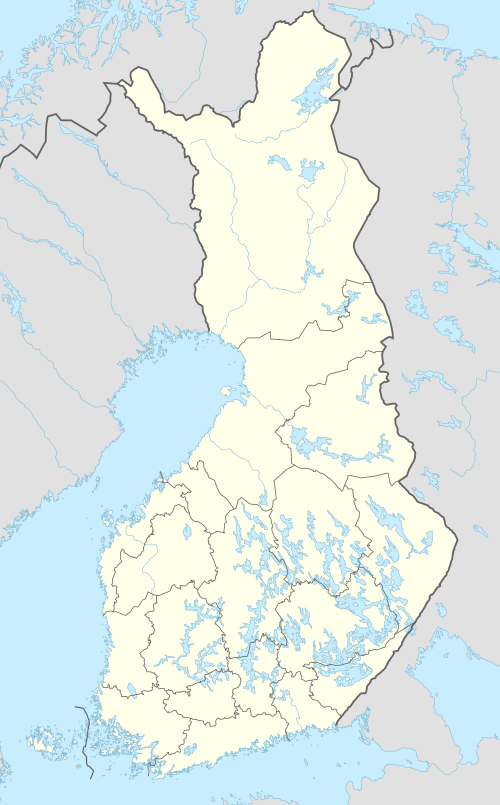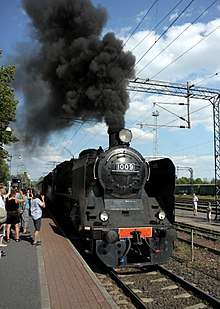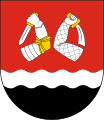Lappeenranta
Lappeenranta (Swedish: Villmanstrand) is a city and municipality situated on the shore of the lake Saimaa in southeastern Finland, about 30 kilometres (19 miles) from the Russian border. It belongs to the region of South Karelia. With approximately 73,000 inhabitants (31 January 2019) Lappeenranta is the 13th largest city in Finland,[6] after incorporating the previous municipalities of Lappee and Lauritsala in 1967, Nuijamaa in 1989, Joutseno in 2009, and Ylämaa in 2010.
Lappeenranta Villmanstrand | |
|---|---|
City | |
| Lappeenrannan kaupunki Villmanstrands stad | |
 The city landscape | |
 Coat of arms | |
 Lappeenranta Location of Lappeenranta in Finland | |
| Coordinates: 61°04′N 028°11′E | |
| Country | |
| Region | |
| Sub-region | Lappeenranta sub-region |
| Charter | 1649 |
| Government | |
| • City manager | Kimmo Jarva |
| Area (2018-01-01)[1] | |
| • Total | 1,723.56 km2 (665.47 sq mi) |
| • Land | 1,433.36 km2 (553.42 sq mi) |
| • Water | 290.14 km2 (112.02 sq mi) |
| Area rank | 47th largest in Finland |
| Population (2019-01-31)[2] | |
| • Total | 72,661 |
| • Rank | 13th largest in Finland |
| • Density | 50.69/km2 (131.3/sq mi) |
| Population by native language | |
| • Finnish | 95.9% (official) |
| • Swedish | 0.1% |
| • Others | 4% |
| Population by age | |
| • 0 to 14 | 15.1% |
| • 15 to 64 | 67% |
| • 65 or older | 17.9% |
| Time zone | UTC+02:00 (EET) |
| • Summer (DST) | UTC+03:00 (EEST) |
| Municipal tax rate[5] | 19.5% |
| Unemployment rate | 14.7% |
| Climate | Dfc |
| Website | www.lappeenranta.fi |
Lappeenranta is known as an international university city in Finland with Lappeenranta University of Technology and Saimaa University of Applied Sciences which together have approximately 13,000 students from 68 countries. Lappeenranta is also a commercial centre of South-East Finland and the meeting point of the EU and Russia, 215 kilometres (134 mi) from both Helsinki and St. Petersburg. Location on the southern shore of Lake Saimaa makes the city the region's centre for tourism. Lappeenranta is the second most visited city by Russian tourists in Finland after Helsinki and it competes with Helsinki for the largest share of tax-free sales in Finland. Lappeenranta is a model for renewable energies and a clean living environment. Lappeenranta was the only Finnish city among the 14 finalists in the international Earth Hour City Challenge 2014, organized by WWF.
History

Pollen analysis has shown that the modern-day municipality of Lappeenranta has been continuously inhabited for at least 2,000 years.[7] Lappeenranta's original core settlement, Lapvesi, later Lappee, was originally formed around a headland jutting into Lake Saimaa, the site of the present fortress. The public market was established here, which became so important as a trading place that general Governor Count Per Brahe the Younger proposed that the Swedish government should grant town privileges to Lapvesi. The town was chartered in 1649 by Queen Christina of Sweden.[8] At the time, Lapvesi was an important port for tar.
Between 1721 and 1743, Lappeenranta was the capital of Kymmenegård and Nyslott County and during this period the Swedes built the fortress out in stages.[9]
In 1741, the Battle of Villmanstrand was fought between the Swedish and Russian armies in the Russo-Swedish War of 1741–1743. The battle ended in a Russian victory. The town was pillaged, wooden structures including the provincial chancellery were burnt and the ecclesiastical archives damaged.
Lappeenranta incorporated the neighbouring municipalities of Lappee and Lauritsala on 1 January 1967, Nuijamaa on 1 January 1989, Joutseno on 1 January 2009, and Ylämaa on 1 January 2010.
Etymology
The name Lappeenranta consists of the genitive of Lappee (the name of the original core town) and the common noun ranta which means "shore". The history of Lappeenranta includes the rural municipality of Lappee and the hundred Lapvesi. The Swedish name Villmanstrand contains the words vildman meaning "wild-man" and strand also meaning "shore". A wild-man is depicted on Lappeenranta's coat of arms.
Climate
It currently has a humid continental climate of the warm-summer type (Köppen: Dfb), formerly in the continental subarctic zone (Dfc) on older data. The summers are longer, although rarely hot, and usually warm. Some of the warmest summers in the country can be found here, due to its orientation: southern but inland. Being in an eastern part of Finland, the winters are often harsh but still mild.[10][11]
Anchorage has some similarities by being of marine influence of hot currents and at the same time of the marginal continentality. But Lappeenranta is still able to receive heat waves that cross Central Europe in a warmer climate than cool.[12]
Climate changes
Between 2000 and 2017 the temperature change was greater than the whole previous century, with +1.2 ° C (higher values than Helsinki or Oulu). Since 2000 the number of warm days (> 24 °C) has become 2 per year, while the 1900 data indicates only 2 days per decade. From the first half of the twentieth century the days above 24 °C changed from rare to occasional in the second half to regular in the present century. There was also a 17.5 decrease in temperature below -1 °C for the same comparison period. 2015 was the hottest year since 1900. Having one of the less than 50 days with freezing days.[13] Work to reduce the temperature increase has been carried out, the city is again among the best 45 cities in the world in the WWF City Challenge 2016. One of the goals is to reduce carbon dioxide by 30% by 2020 and zero emissions by 2050.[14]
| Climate data for Lappeenranta, 1961-1990 normals and extremes | |||||||||||||
|---|---|---|---|---|---|---|---|---|---|---|---|---|---|
| Month | Jan | Feb | Mar | Apr | May | Jun | Jul | Aug | Sep | Oct | Nov | Dec | Year |
| Record high °C (°F) | 5.6 (42.1) |
7.5 (45.5) |
13.1 (55.6) |
21.6 (70.9) |
28.9 (84.0) |
31.2 (88.2) |
33.1 (91.6) |
30.7 (87.3) |
27.1 (80.8) |
17.4 (63.3) |
11.4 (52.5) |
6.7 (44.1) |
33.1 (91.6) |
| Average high °C (°F) | −6.5 (20.3) |
−5.7 (21.7) |
−0.2 (31.6) |
6.4 (43.5) |
14.8 (58.6) |
19.7 (67.5) |
21.3 (70.3) |
19.1 (66.4) |
13.0 (55.4) |
6.9 (44.4) |
0.8 (33.4) |
−3.6 (25.5) |
7.2 (44.9) |
| Daily mean °C (°F) | −9.4 (15.1) |
−8.8 (16.2) |
−3.8 (25.2) |
2.3 (36.1) |
9.8 (49.6) |
14.8 (58.6) |
16.7 (62.1) |
14.8 (58.6) |
9.5 (49.1) |
4.2 (39.6) |
−1.2 (29.8) |
−6.2 (20.8) |
3.6 (38.4) |
| Average low °C (°F) | −12.7 (9.1) |
−12.2 (10.0) |
−7.5 (18.5) |
−1.6 (29.1) |
4.6 (40.3) |
9.8 (49.6) |
12.1 (53.8) |
10.9 (51.6) |
6.3 (43.3) |
1.6 (34.9) |
−3.4 (25.9) |
−9.3 (15.3) |
−0.1 (31.8) |
| Record low °C (°F) | −36.8 (−34.2) |
−33.3 (−27.9) |
−28.0 (−18.4) |
−16.8 (1.8) |
−6.0 (21.2) |
−0.4 (31.3) |
4.4 (39.9) |
1.7 (35.1) |
−4.8 (23.4) |
−12.1 (10.2) |
−21.1 (−6.0) |
−30.8 (−23.4) |
−36.8 (−34.2) |
| Average precipitation mm (inches) | 37.0 (1.46) |
29.0 (1.14) |
33.0 (1.30) |
31.0 (1.22) |
31.0 (1.22) |
50.0 (1.97) |
67.0 (2.64) |
82.0 (3.23) |
71.0 (2.80) |
64.0 (2.52) |
58.0 (2.28) |
50.0 (1.97) |
603 (23.75) |
| Average precipitation days (≥ 1.0 mm) | 10.0 | 8.0 | 8.0 | 7.0 | 7.0 | 8.0 | 10.0 | 12.0 | 11.0 | 12.0 | 13.0 | 12.0 | 118 |
| Mean monthly sunshine hours | 33.2 | 72.6 | 132.3 | 179.9 | 262.6 | 267.0 | 259.9 | 209.1 | 123.6 | 71.6 | 24.5 | 18.7 | 1,655 |
| Source: NOAA[15] | |||||||||||||
Education
Lappeenranta has numerous schools at almost all levels of education, including the Lappeenranta University of Technology, Saimaa University of Applied Sciences, located in a shared Skinnarila campus of around 8000 students, the Army Academy (branch of the Finnish Defence Forces), South Karelia Vocational College and South Karelia Adult Education Centre.
Transport

Lappeenranta is connected to neighbouring cities and municipalities by road. The city is located 215 km from Helsinki and 195 km from St. Petersburg.
There are multiple daily train departures to destinations within Finland from the Lappeenranta Central Station and to Russia from Vainikkala station. The Allegro train service operating between Helsinki and St. Petersburg stops in Vainikkala, a village in Lappeenranta. The journey time to Helsinki is about 2 hours and St. Petersburg about 1.5 hours.
During the summer, when Lake Saimaa and the Saimaa Canal are accessible by water, there is a visa-free connection by ship from Lappeenranta to Vyborg, Russia.
The regionally owned Lappeenranta Airport is located west of the city center.[16] The airport predominantly serves charter flights to southern Europe, the Canary Islands and Madeira.
Economy
The city's main employers are the:
- City of Lappeenranta
- UPM-Kymmene
- South Karelia Social and Health Care District
- Lappeenranta University of Technology
- Paroc
- Nordkalk
- VR Group
- Fazer
- The Armed Forces
- Outotec
Sports

Lappeenranta has multiple sports teams playing in top levels of Finnish sports leagues.
SaiPa is an Ice hockey team playing in the highest level in Finland, SM-liiga. SaiPa was fourth in the national Ice hockey league in the season of 2013–2014. 2014 IIHF Ice Hockey U18 World Championship - Tournament was played Kisapuisto Ice Hall, Lappeenranta & Imatra Ice Hall during 17–27 April 2014. United States won the tournament, Czech Republic was second and Canada was the third.
Namika Lappeenranta is a basketball team playing in the highest level in Korisliiga and have won two championships in 2005 and 2006.
NST plays floorball in the Salibandyliiga and Rajaritarit is an American football team in the Vaahteraliiga.
Lappeenrannan Veiterä, or just Veiterä, plays in Bandyliiga and has been Finnish champions five times, including in 2017. They have been the champions for women and for girls born in 1995 and 1998.[18] The city hosted the first ever Women's Bandy World Championship in 2004 and in 2014 the tournament was again played in Lappeenranta. The Old Boys World Cup is annually hosted in town, in 2017 for the seventh time.
In women's sports Catz Lappeenranta plays basketball and Pesä Ysit plays Finnish baseball, both in the top leagues of the nation. Catz has won Finnish national basketball championship four times in a row.
Notable people
- Antti Aalto – former ice-hockey player
- Koop Arponen – singer and winner of the fourth series of the Idols in 2008
- Kaarlo Halttunen – former actor
- Laila Hirvisaari (formerly Laila Hietamies) – novelist, has written a novel series about Lappeenranta and its people
- Horna – Finnish black metal band
- Kari Jormakka – philosopher, architect, architecture theorist
- Kotiteollisuus – hard rock band
- Pave Maijanen – musician
- Miikka Multaharju – football player
- Jaska Raatikainen - drummer of the band Children of Bodom
- Jukka Paarma – former Archbishop of Turku and Finland
- Tiia Piili – gymnast
- Saku Puhakainen – football player
- Sargeist - Finnish black metal band
- Satanic Warmaster – Finnish black metal band
- Petri Skriko – retired ice-hockey player in the NHL in USA
- Juha Tiainen – former Olympic gold medallist in hammer throw
- Mokoma – thrash metal band
- Battlelore - symphonic metal band
- Hanna Pakarinen – the first Idols winner in Finland came from Lappeenranta
- Christian Ruuttu – former ice hockey player in the NHL
- Vesa Vierikko – Finnish actor
- Vesa Viitakoski – former ice hockey player in SM-liiga
Tourism

Lappeenranta is known as a summer city, mostly due to its closeness to the Lake Saimaa. Europe's 4th largest lake. The eponymous GoSaimaa (www.gosaimaa.com) provides all the touristic activities in the area. In addition, its inland location means that summers tend to be warmer and winters colder than along the coastal areas.
Lappeenranta does have a healthy winter tourism industry. Various cabins around Lake Saimaa, as well as numerous snowmobiles, Nordic skating, floating in the river, reindeer rides, paragliding, skiing and sledding tracks draw a fair number of winter visitors.
The proximity of the Russian border is increasingly evident in the number of Russian tourists visiting the city. In fact, Lappeenranta is closer to Saint Petersburg (195 km or 121 miles) than it is to Helsinki, the capital of Finland (220 km or 140 miles). The presence of Russian tourists is noticeable by the many Russian registered cars on the streets and the use of Cyrillic letters in signs of some shops.
Places and events
- The old fortress, with a number of museums, cafés and the oldest Russian Orthodox church in Finland.
- St. Mary's Church of Lappee, an 18th-century wooden church in the center of the city.
- The harbour area, with cruises to Vyborg and the nearby Saimaa Canal.
- The central market place, where you can enjoy the local specialities, such as meat pies known as "Atomi" (atom) or "Vety" (hydrogen).
- The Night of The Fortess, a two-day cultural festival held in early August.
- The Lappeenranta Ballet Gala in late August.[19]
- The annual Lappeenranta National Singing Contest.
- The biggest sand castle in Finland is built next to Port of Lappeenranta every summer.[20]
- There are three private cinema theatres in Lappeenranta: Kino-Aula, Nuijamies and Finnkino.
- Major league home games in ice-hockey (SaiPa), basketball (Namika Lappeenranta) and other sports.
- The IIHF World Championship Under 18, in 2014
- Unlimited Racing Event, on 27 and 29 June 2014
In media
Lappeenranta is the setting for Bordertown, the Finnish police drama broadcast by Netflix.
Twin towns – sister cities
Lappeenranta is twinned with:[21]









Image gallery
 Lappeenranta harbour
Lappeenranta harbour- Town Hall
 Lappeenranta University of Technology
Lappeenranta University of Technology Kauppakatu street
Kauppakatu street- Port of Lappeenranta by day
References
- "Area of Finnish Municipalities 1.1.2018" (PDF). National Land Survey of Finland. Retrieved 30 January 2018.
- "Suomen virallinen tilasto (SVT): Väestön ennakkotilasto [verkkojulkaisu]. Tammikuu 2019" (in Finnish). Statistics Finland. Retrieved 15 March 2019.
- "Population according to language and the number of foreigners and land area km2 by area as of 31 December 2008". Statistics Finland's PX-Web databases. Statistics Finland. Retrieved 29 March 2009.
- "Population according to age and gender by area as of 31 December 2008". Statistics Finland's PX-Web databases. Statistics Finland. Retrieved 28 April 2009.
- "List of municipal and parish tax rates in 2011". Tax Administration of Finland. 29 November 2010. Retrieved 13 March 2011.
- "Ennakkoväkiluku sukupuolen mukaan alueittain, maaliskuu.2016" (in Finnish). Statistics Finland. Archived from the original on 20 May 2016. Retrieved 31 March 2016.
- "History". Ramboll Finland Oy. Retrieved 4 August 2020.
- "History". City of Lappeenranta. Retrieved 4 March 2019.
- "Fortress, History". City of Lappeenranta. Retrieved 4 March 2019.
- "Lappeenranta, Finland Köppen Climate Classification (Weatherbase)". Weatherbase. Retrieved 2019-03-04.
- "Lappeenranta Climate Lappeenranta Temperatures Lappeenranta Weather Averages". www.lappeenranta.climatemps.com. Retrieved 2019-03-04.
- "Average Weather in Lappeenranta, Finland, Year Round - Weather Spark". weatherspark.com. Retrieved 2019-03-04.
- "Europe 1° Warmer: Lappeenranta". www.onedegreewarmer.eu. Retrieved 2019-03-04.
- "LAPPENRANTA Green Reality".
- "Lappeenranta (02958) - WMO Weather Station". NOAA. Retrieved March 4, 2019.
- "Lappeenranta Airport acquired by new company / News archive". Finavia. Retrieved 2017-02-12.
- Statistics Archived 2011-07-19 at the Wayback Machine. (In Finnish) The city of Lappeenranta, Retrieved 13 January 2011.
- Kampparit new Finnish Champions in bandy Archived 2014-04-19 at the Wayback Machine
- Lappeenranta Ballet Gala Archived 2011-07-19 at the Wayback Machine. The city of Lappeenranta, Retrieved 14 January 2011.
- Sandcastle Lappeenranta Archived 2010-10-11 at the Wayback Machine. The official homepage of the Lappeenranta sandcastle, Retrieved 14 January 2011.
- "Twin cities". Retrieved 29 April 2014.
- "Twin Cities". Rakvere. Archived from the original on 14 October 2013. Retrieved 30 April 2014.
- "Schwäbisch Hall and its twin towns". Stadt Schwäbisch Hall. Archived from the original on 2014-09-26. Retrieved 2013-07-26.
External links
| Wikimedia Commons has media related to Lappeenranta. |
- Official tourism site
- Official site
- Official Saimaa tourism site

